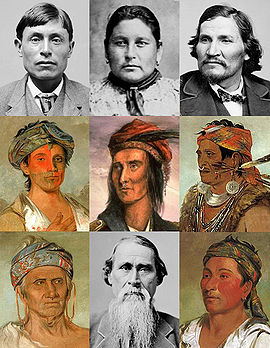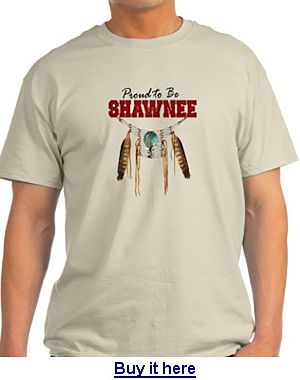The Eastern Shawnee Tribe of Oklahoma are descended from the mixed Seneca-Shawnee band which left Lewistown, Ohio and came to the Indian Territory in 1832. Recognized as a separate tribe in 1867, they organized as the Eastern Shawnee Tribe of Oklahoma during the 1930s.
Official Tribal Name: Eastern Shawnee Tribe of Oklahoma
Address: 127 West Oneida Street, PO Box 350, Seneca, Missouri 64865
Phone: 866-674-3786
Fax: 888-971-3905 (Please indicate department)
Email:
Official Website: www.estoo-nsn.gov
Recognition Status: Federally Recognized
Traditional Name / Traditional Meaning:
Shawnee comes from the Algonquin word “shawun” (shawunogi) meaning “southerner.” However, this referred to their original location in the Ohio Valley relative to other Great Lakes Algonquin rather than a homeland in the American southeast. Shawnee usually prefer to call themselves the Shawano – sometimes given as Shawanoe or Shawanese.
Common Name: Shawnee
Meaning of Common Name:
Alternate names:
South Carolina colonists knew them as the Savannah or Savannuca.
Also Cumberland Indians
Alternate spellings / Mispellings:
Name in other languages:
Ani-Sawanugi (Cherokee)
Chaouanons (Chauenon) (French)
Chaskpe (Chaouesnon) (French)
Chiouanon (Seneca)
Ontwagnnn (Iroquois, meaning “one who stutters”)
Oshawanoag (Ottawa)
Satana (Iroquois)
Shawala (Lakota)
Touguenha (Iroquois)
Region: Northeast
State(s) Today: Oklahoma
Traditional Territory:
The Shawnee Indians originally inhabited areas around what is now Ohio, Pennsylvania and West Virginia. In the late 17th Century, however, the were invaded by their traditional enemy, the Iroquois and driven from their lands. They were driven into South Carolina, eastern Pennsylvania and southern Illinois. With the coming of the white man the Shawnee were again forced to move from their home country. They were gradually driven west, first to Missouri, then Kansas and finally Oklahoma.
Confederacy: Shawnee Tribes, Tecumseh’s Confederacy
Treaties:
The 1817 Treaty of Fort Meigs granted the Shawnees still in northwest Ohio three reservations: Wapakoneta, Hog Creek, and Lewistown. By 1824, about 800 Shawnees lived in Ohio and 1,383 lived in Missouri. In 1825, Congress ratified a treaty with the Cape Girardeau Shawnees ceding their Missouri lands for a 1.6 million-acre reservation in eastern Kansas. After the Indian Removal Act of 1830, the Ohio Shawnees on the Wapakoneta and Hog Creek reservations signed a treaty with the US giving them lands on the Kansas Reservation.
The Lewistown Reservation Shawnees, together with their Seneca allies and neighbors, signed a separate treaty with the federal government in 1831 and moved directly to Indian Territory (Oklahoma). The Lewistown Shawnees became the Eastern Shawnee Tribe of Oklahoma, while their Seneca allies became the Seneca-Cayuga Tribe of Oklahoma.
In 1854, the US government decimated the Kansas Reservation to 160,000 acres. This, coupled with the brutal abuses perpetrated against them by white settlers during and after the Civil War, forced the Kansas Shawnees to relocate to Cherokee Nation in northeastern Oklahoma. The 1854 Shawnee Reservation in Kansas was never formally extinguished and some Shawnee families retain their Kansas allotments today.
The federal government caused the former Kansas Shawnees and the Cherokees to enter into a formal agreement in 1869, whereby the Shawnees received allotments and citizenship in Cherokee Nation.
The Shawnees settled in and around White Oak, Bird Creek (Sperry), and Hudson Creek (Fairland), maintaining separate communities and separate cultural identities. Known as the Cherokee Shawnees, they would also later be called the Loyal Shawnees.
Initial efforts begun in the 1980s to separate the Shawnee Tribe from Cherokee Nation culminated when Congress enacted Public Law 106-568, the Shawnee Tribe Status Act of 2000, which restored the Shawnee Tribe to its position as a sovereign Indian nation.
Reservations:
Land Area:
Tribal Headquarters:
Time Zone: Central
Population at Contact:
The pre European Shawnee population numbered somewhere around 10,000. The first US Census in 1825 gave 1400 Shawnee in Missouri, 1100 in Louisiana, and 800 in Ohio.
Registered Population Today:
Today, there are three official groups of the Shawnee. The largest group is the Loyal Shawnee. They number about 8,000 individuals. They were originally recognised by the United States Government as part of the Cherokee Nation, however they finally gained federal recognition as a separate Shawnee Tribe in 2000. The Eastern Shawnee tribe of Oklahoma has about 1,600 members. There are about 2,000 Absentee Shawnee. A fourth group is the Shawnee Nation United Remnant Band who number about six hundred. However, they are not recognised by the Federal Government. The total modern Shawnee population, then, stands at about 14,000.
Tribal Enrollment Requirements:
Genealogy Resources:
Government:
Charter:
Name of Governing Body:
Number of Council members:
Dates of Constitutional amendments:
Number of Executive Officers:
Elections:
Language Classification: Algonquin
Language Dialects: Southern Great Lakes (Wakashan) dialect closely related to Fox, Sauk, Mascouten, and Kickapoo.
Number of fluent Speakers:
Dictionary:
Origins:
The Shawnee considered the Delaware as their “grandfathers” and the source of all Algonquin tribes. They also shared an oral tradition with the Kickapoo that they were once members of the same tribe. Identical language supports this oral history, and since the Kickapoo are known to have originally lived in northeast Ohio prior to contact, it can safely be presumed that the Shawnee name of “southerner” means they lived somewhere immediately south of the Kickapoo. However, the exact location is uncertain, since the Iroquois forced both tribes to abandon the area before contact.
Related Tribes:
- Absentee Shawnee (F)
- Eastern Shawnee Tribe of Oklahoma (F)
- Shawnee Tribe (F)
- Piqua Shawnee Tribe (S)
- Chickamauga Keetoowah Unami Wolf Band of Cherokee Delaware Shawnee of Ohio, West Virginia, and Virginia. (U)
- East of the River Shawnee, Ohio (U)
- Kispoko Sept of Ohio Shawnee, Louisiana (U)
- Kispoko Sept of Ohio Shawnee (Hog Creek Reservation), Ohio (U)
- Lower Eastern Ohio Mekoce Shawnee, Ohio Letter of Intent to Petition 3/5/2001. (U)
- Lower Eastern Ohio Mekojay Shawnee, Ohio (U)
- Morning Star Shawnee Nation, Ohio (U)
- Platform Reservation Remnant Band of the Shawnee Nation (U)
- Shawnee Nation Blue Creek Band, of Adams County, Ohio. Letter of Intent to Petition 8/5/1998. (U)
- Piqua Sept of Ohio Shawnee Tribe—Letter of Intent to Petition 04/16/1991. (U)
- Ridgetop Shawnee, Kentucky. In 2009 and 2010, the State House of the Kentucky General Assembly recognized the Ridgetop Shawnee Tribe of Indians by passing House Joint Resolutions 15 or HJR-15 and HJR-16. (U)
- Southeastern Kentucky Shawnee, Kentucky (U)
- Shawnee Nation United Remnant Band, Ohio (U)
- United Tribe of Shawnee Indians, Kansas (U)
- Upper Kispoko Band of the Shawnee Nation, Indiana (U)
- Vinyard Indian Settlement of Shawnee Indians, Illinois (U)
- Youghiogaheny River Band Of Shawnee Indians, Maryland (U)
The Shawnee Tribe was once part of the Cherokee Nation.
Traditional Allies: The closest allies of the Shawnee were the Kickapoo and Delaware. Further to the south, the most important neighbors of the Shawnee tribe were the Cherokee, Chickasaw, and Creek Indians. Sometimes the Shawnees traded with these tribes, and other times they fought them.
Traditional Enemies: They always considered the Iroquois to be enemies.
Bands and Clans:
Bloodlines are patriarchial, meaning they are traced through the father’s lines.
Ceremonies / Dances:
Many important Shawnee ceremonies were tied to the agricultural cycle: the spring bread dance at planting time; the green corn dance when crops ripened; and the autumn bread dance to celebrate the harvest.
Modern Day Events & Tourism:
Legends / Oral Stories:
Crafts / Musical Instruments: The Eastern Shawnee tribe is known for their beadwork, pottery, and wood carving. Like other eastern American Indians, the Shawnee also crafted wampum out of white and purple shell beads. Wampum beads were traded as a kind of currency, but they were more culturally important as an art material. The designs and pictures on wampum belts often told a story or represented a person’s family. Musical instruments included drums and deer-hoof rattles. The Shawnees made dugout canoes by hollowing out large trees.
Animals: Before Europeans brought horses back to North America, the Shawnee used dogs as pack animals.
Clothing: Shawnee women wore skirts with leggings. Shawnee men wore breechclouts and leggings. Shirts were not necessary for either sex in the Shawnee culture, but both men and women often wore ponchos in cool weather. The Shawnees wore moccasins on their feet. As they migrated from place to place, the Shawnees adopted clothing styles from many other Indian tribes and from white settlers.
The Shawnees didn’t wear full headdresses like the Sioux. Sometimes they wore a beaded headband with a feather or two in it. Shawnee people usually wore their hair long, though Shawnee warriors sometimes shaved their heads in the Mohawk style. Many Shawnees painted designs onto their faces, and some wore tribal tattoos.
Housing:
During the summer the Shawnee gathered into large villages of bark-covered long houses, with each village usually having a large council house for meetings and religious ceremonies. In the fall they separated to small hunting camps of extended families.
Subsistance:
The Shawnee were semi-sedentary farmers who left their central villages in the fall for hunting excursions in smaller family groups. Men were warriors and did the hunting and fishing. Care of their corn fields and building homes were the responsibility of the women.
Economy Today:
Religion & Spiritual Beliefs:
Burial Customs:
Wedding Customs
Radio:
Newspapers:
Famous Shawnee Chiefs and Leaders:
Public Domain via Wikimedia Commons Tecumseh –
Tecumseh –
Tenskwatawa (The Prophet, brother of Tecunseh) –
Cornstalk –
Blackfish –
Black Hoof –
Bluejacket –
Catastrophic Events:
Tribe History:
The loss of their homeland has given the Shawnee the reputation of being wanderers, but this was by necessity, not choice. The Shawnee have always maintained a strong sense of tribal identity, but this produced very little central political organization. During their dispersal, each of their five divisions functioned as an almost autonomous unit. This continued to plague them after they returned to Ohio, and few Shawnee could ever claim to the title of “head chief.”
Like the Delaware, Shawnee civil chiefships were hereditary and held for life. They differed from the Delaware in that, like most Great Lakes Algonquin, the Shawnee were patrilineal with descent traced through the father. War chiefs were selected on the basis of merit and skill.
During their stay in the southeast, the Shawnee acquired a some cultural characteristics from the Creek and Cherokee, but, for the most part, they were fairly typical Great Lakes Algonquin.
In the News:
Further Reading:


